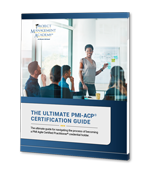A question that I’m asked regularly during my classes is what the best place is to start agile transformations within a company? Given a choice, I’d prefer to use the cop-out (but correct) answer “It depends”, but otherwise I usually respond that you’d want to do both a top-down and bottom-up approach simultaneously.

Download the Ultimate Guide to learning about the PMI-ACP Certification.
A common approach for major organizational changes is to start at the top with executive leadership, creating a coalition of commitment and support towards a shared vision for the future. This is critical with agile transformations for a number of reasons:
- Delivery teams don’t work in isolation and hence buy-in to change how things are done will be needed from all supporting areas including human resources, finance and procurement.
- There will be the need for funding investments such as training, coaching, tooling and potentially even staffing new positions.
- Without changing existing portfolio intake practices and performance measures (e.g. shifting from a focus from maximizing utilization to maximizing value), it will be hard to achieve the full benefits of the transformation.
- To shift the established behaviors of middle management towards an agile mindset, the executive team needs to model the desired target behaviors first. Not only will the executives need to be coached to get there, they must also agree to hold each other visibly accountable to this new way of working.
- There needs to be a unifying vision for the transformation as well as a roadmap for how to get there. The executive team must be fully engaged in the creation of these key deliverables.
Studying for the PMP Exam?
 But there will also be the need to have engagement at the delivery team level. If individual team members are comfortable with how things are working and have no sense of urgency about the need for change, then their support will be superficial. For agile transformations, their buy-in is needed to:
But there will also be the need to have engagement at the delivery team level. If individual team members are comfortable with how things are working and have no sense of urgency about the need for change, then their support will be superficial. For agile transformations, their buy-in is needed to:
- Develop the details of the new ways of working and inspect and adapt those over time.
- Feel comfortable designing and conducting experiments and having the occasional setback with those.
- Be willing to take on new roles and responsibilities.
- Be open to providing stakeholders with a greater level of transparency into their work and work flow than they have been used to.
- Collaborate openly with contributors from other functional areas whom they previously might have just cooperated with.
While these outcomes are needed, a key benefit of taking this top-down & bottom-up approach is that it will create a “sandwich effect” squeezing those middle managers who are unwilling to change how they work. Without that outcome, it is unlikely that an agile transformation will succeed.
To read more articles by Kiron Bondale, visit his blog.
Upcoming PMP Certification Training – Live & Online Classes
| Name | Date | Place |


 New Horizons
New Horizons
 Project Management Academy
Project Management Academy
 Six Sigma Online
Six Sigma Online
 TCM Security
TCM Security
 TRACOM
TRACOM
 Velopi
Velopi
 Watermark Learning
Watermark Learning
 Login
Login




 New Horizons
New Horizons
 Project Management Academy
Project Management Academy
 Velopi
Velopi
 Six Sigma Online
Six Sigma Online
 TCM Security
TCM Security
 TRACOM
TRACOM
 Watermark Learning
Watermark Learning